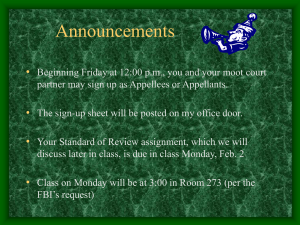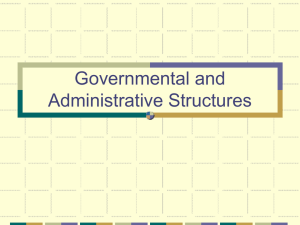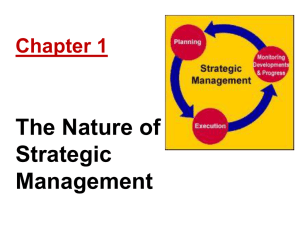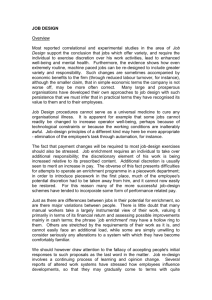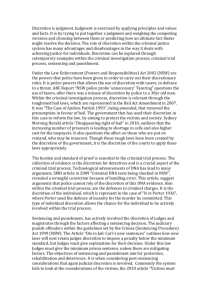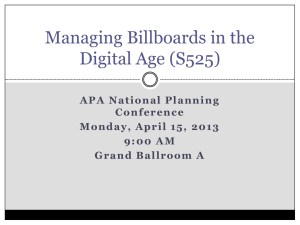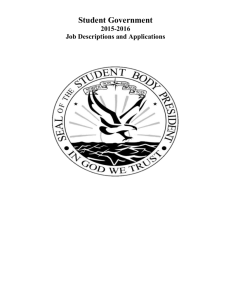“Mixed” Questions
advertisement
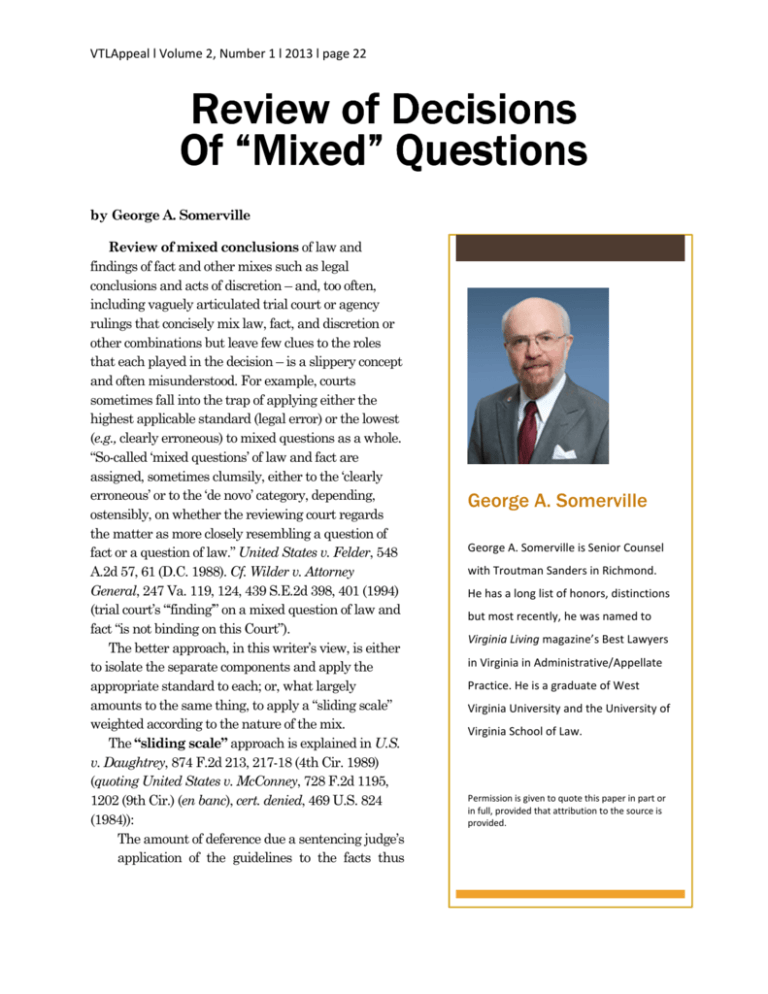
VTLAppeal l Volume 2, Number 1 l 2013 l page 22 Review of Decisions Of “Mixed” Questions by George A. Somerville Review of mixed conclusions of law and findings of fact and other mixes such as legal conclusions and acts of discretion – and, too often, including vaguely articulated trial court or agency rulings that concisely mix law, fact, and discretion or other combinations but leave few clues to the roles that each played in the decision – is a slippery concept and often misunderstood. For example, courts sometimes fall into the trap of applying either the highest applicable standard (legal error) or the lowest (e.g., clearly erroneous) to mixed questions as a whole. “So-called ‘mixed questions’ of law and fact are assigned, sometimes clumsily, either to the ‘clearly erroneous’ or to the ‘de novo’ category, depending, ostensibly, on whether the reviewing court regards the matter as more closely resembling a question of fact or a question of law.” United States v. Felder, 548 A.2d 57, 61 (D.C. 1988). Cf. Wilder v. Attorney General, 247 Va. 119, 124, 439 S.E.2d 398, 401 (1994) (trial court’s “‘finding’” on a mixed question of law and fact “is not binding on this Court”). The better approach, in this writer’s view, is either to isolate the separate components and apply the appropriate standard to each; or, what largely amounts to the same thing, to apply a “sliding scale” weighted according to the nature of the mix. The “sliding scale” approach is explained in U.S. v. Daughtrey, 874 F.2d 213, 217-18 (4th Cir. 1989) (quoting United States v. McConney, 728 F.2d 1195, 1202 (9th Cir.) (en banc), cert. denied, 469 U.S. 824 (1984)): The amount of deference due a sentencing judge’s application of the guidelines to the facts thus George A. Somerville George A. Somerville is Senior Counsel with Troutman Sanders in Richmond. He has a long list of honors, distinctions but most recently, he was named to Virginia Living magazine’s Best Lawyers in Virginia in Administrative/Appellate Practice. He is a graduate of West Virginia University and the University of Virginia School of Law. Permission is given to quote this paper in part or in full, provided that attribution to the source is provided. VTLAppeal l Volume 2, Number 1 l 2013 l page 23 depends on the circumstances of the case. If the issue turns primarily on a factual determination, an appellate court should apply the “clearly erroneous” standard…. If the issue, for example, turns primarily on the legal interpretation of a guideline term, which of several offense conduct guidelines most appropriately apply to the facts as found, or the application of the grouping principles, see Guideline §§ 3D1.1, et seq., the standard moves closer to de novo review. The due deference standard is, then, the standard courts have long employed when reviewing mixed questions of fact and law. On mixed questions, courts have not defined any bright-line standard of review. Rather, the standard of review applied varies with the “mix” of the mixed question. If the question: [I]s ‘essentially factual,’ … the concerns of judicial administration will favor the district court, and the district court’s determination should be classified as one of fact reviewable under the clearly erroneous standard. If, on the other hand, the question requires us to consider legal concepts in the mix of fact and law and to exercise judgment about the values that animate legal principles, then the concerns of judicial administration will favor the appellate court, and the question should be classified as one of law and reviewed de novo. The “components” approach is described in Universal Minerals, Inc. v. C.A. Hughes & Co., 669 F.2d 98, 103 (3d Cir. 1981) (applying federal standards of appellate review in a case governed substantively by Pennsylvania law): Abandonment [of personal property] is not a question of narrative or historical fact but an ultimate fact, a legal concept with a factual component…. It is “a conclusion of law or at least a determination of a mixed question of law and fact,” … requiring “the application of a legal standard to the historical-fact determinations” …. In reviewing the ultimate determination of abandonment, as an appellate court, we are therefore not limited by the “clearly erroneous” standard, … but must employ a mixed standard of review. We must accept the trial court’s findings of historical or narrative facts unless they are clearly erroneous, but we must exercise a plenary review of the trial court’s choice and interpretation of legal precepts and its application of those precepts to the historical facts…. Thus we separate the distinct factual and legal elements of the trial court’s determination of an ultimate fact and apply the appropriate standard to each component. We employ the same approach when we review a jury’s findings on a mixed question, but the distinction is more easily understood in that context because of the strict division of competences between the jury and the trial court and the intercession of the seventh amendment. If a jury finds that a party has abandoned an VTLAppeal l Volume 2, Number 1 l 2013 l page 24 interest in property, we review the court’s jury instructions to determine whether the court erred in its explanation of the law, and if we find no error we examine the record to determine whether the evidence was sufficient to justify a reasonable mind in drawing the factual inferences underlying the conclusion. With the sole exception of the different review standard of judicial findings expressed by the phrase “clearly erroneous,” we go through the same process when the court sits as both finder of the facts and arbiter of the law. [Citations and footnotes omitted.] See also, e.g., Gilbane Building Co. v. Federal Reserve Bank of Richmond, 80 F.3d 895, 905 (4th Cir. 1996) (“[W]e do not review mixed questions for abuse of discretion. We review them under a hybrid standard, applying to the factual portion of each inquiry the same standard applied to questions of pure fact and examining de novo the legal conclusions derived from those facts”); Scott v. Burwell’s Bay Improvement Ass’n., 281 Va. 704, 709, 708 S.E.2d 858, 861 (2011) (applying components approach to mixed questions of law and fact in an adverse possession and prescription case); Buhrman v. Commonwealth, 275 Va. 501, 504-05, 659 S.E.2d 325, 327 (2008) (“This Court gives deference to the historical facts determined by the trial court, but we apply a de novo standard of review when considering whether the legal standard of probable cause was correctly applied by the trial court to the historical facts”); Westgate v. Philip Richardson Co., Inc., 270 Va. 566, 574, 621 S.E.2d 114, 118 (2005) (“We review questions of law de novo, including those situations where there is a mixed question of law and fact”); Bass v. City of Richmond Police Dept., 258 Va. 103, 114, 115, 117, 515 S.E.2d 557, 562-64 (1999) (Workers’ Compensation Commission’s awards held “conclusive and binding as to all questions of fact” but cases remanded for reconsideration of evidence using proper statutory standard). In Ray Communications, Inc. v. Clear Channel Communications, Inc., 673 F.3d 294, 299 (4th Cir. 2012), the Fourth Circuit applied a components approach (without using that term) in reviewing a summary judgment based on a finding of laches: At the outset …, we clarify the two-part standard applicable to our review of a laches determination made on summary judgment. As is generally the case, we review the district court’s grant of summary judgment de novo…. Summary judgment is appropriate when there is no genuine issue of material fact and the moving party is entitled to judgment as a matter of law…. On the other hand, we review the district court’s application of the equitable doctrine of laches for abuse of discretion…. The court “has abused its discretion if its decision is guided by erroneous legal principles or rests upon a clearly erroneous factual finding.” … Accordingly, where a district court has granted summary judgment on the basis of laches, we review the sufficiency of the evidence in support of or in opposition to summary judgment de novo, but we review the district court’s application of laches elements to the undisputed material facts for abuse of discretion…. In other words, “as long as the district VTLAppeal l Volume 2, Number 1 l 2013 l page 25 court applies the correct legal standard on summary judgment and does not resolve disputed issues of material fact against the nonmovant, its determination of whether the undisputed facts warrant an application of laches is reviewed for an abuse of discretion.” [Citations omitted.] Preliminary injunction cases often present mixed questions that require either the application of a sliding scale or separation into legal, factual, and discretionary components. The Fourth Circuit follows the “components” approach in this context. It has explained, for example, that its review of the factual components of a trial court’s decision is governed by the “clearly erroneous” standard; “[t]he [trial] court’s application of legal principles, however, presents a legal question that is reviewed de novo.” State of North Carolina v. City of Virginia Beach, 951 F.2d 596, 601 (4th Cir. 1991). See WV Association of Club Owners and Fraternal Services, Inc., v. Musgrave, 553 F.3d 292, 298 (4th Cir. 2009) (“We review the district court’s grant of a preliminary injunction for abuse of discretion. Accordingly, we review factual findings for clear error and legal conclusions de novo”). And while appellate courts sometimes hold that a grant or denial of injunctive relief will be set aside only for an abuse of discretion (echoing a fading tradition), that statement alone is too “simplistic”; for example the trial court may have “failed to exercise its discretion in some respect or else exercised it counter to established equitable principles.” Blackwelder Furniture Co. v. Seilig Mfg. Co., 550 F.2d 189, 193 (4th Cir. 1977).1 But cf. Ashcroft v. American Civil Liberties Union, 542 U.S. 656, 664 (2004) (“‘This Court, like other appellate courts, has always applied the abuse of discretion standard on the review of a preliminary injunction’”) (citation omitted). To the extent that decisions on issues of equitable relief remain discretionary, the trial courts’ discretion has grown “weaker” than when appellate courts began applying the rubric of discretion because today it is largely governed by rules of law that courts have established after much institutional experience. Either application of legally erroneous criteria to an issue committed to discretion or a failure to exercise discretion that is conferred (on the ground that the issue is legal or factual, or out of simple carelessness) is a legal error and not an abuse of discretion. Illustrating how appellate courts exercise a mixed standard of review in injunction actions, the Blackwelder court held that the trial court had failed to apply settled principles of law and reversed its refusal to grant preliminary relief. Id. at 193-98. It also found that the trial court’s findings in part were clearly erroneous. Id. at 196-97. Key to this analysis is that it did not even review the trial court’s exercise of discretion or hold that it was abused; it held that the court entered that exercise with the wrong questions. Similarly, in North Carolina v. Virginia Beach, the Fourth Circuit ordered the trial court to modify an injunction, holding that the restraint went beyond what was reasonably required to accomplish its end and to that extent could not “as a matter of law be justified.” 951 F.2d at 602-03. The court accorded “due regard to the factual findings of the court below” but reviewed the trial court’s application of prior case law to those facts de novo, as a matter of law. Id. at 601. And like the Blackwelder court, it did not explicitly review the trial court’s exercise of discretion or hold that it had been abused. VTLAppeal l Volume 2, Number 1 l 2013 l page 26 Courts are not always comfortable with these distinctions, however. The most common confusion appears to be in applying (correctly) a legal error standard of review to questions that are thought (incorrectly) to be governed by an abuse of discretion standard. See, e.g., Meyer v. Brown, 256 Va. 53, 56-58, 500 S.E.2d 807, 809-10 (1998) (reviewing a trial court’s decision overruling a defendant’s objection to venue, ostensibly for abuse of discretion, but reversing the decision at least seemingly for legal error in the trial court’s reading of the governing statute (Va. Code § 8.01-262)); Advanced Marine Enterprises, Inc. v. PRC, Inc., 256 Va. 106, 125-26, 501 S.E.2d 148, 15960 (1998) (reversing chancellor’s award of litigation expenses for legal error – awarding costs not authorized by statute – but rhetorically charging the chancellor with an abuse of discretion). Courts which believe that they are required to apply an abuse of discretion standard to issues of law commonly dodge the issue by intoning that “[a]n error of law constitutes an abuse of discretion.” E.g., A Helping Hand v. Baltimore County, 515 F.3d 356, 370 (4th Cir. 2008); Lynchburg Division of Social Services v. Cook, 276 Va. 465, 484, 666 S.E.2d 361, 370 (2008) (“A court by definition abuses its discretion when it makes an error of law”) (citations and internal quotation marks omitted). See also Landrum v. Chippenham & Johnston-Willis Hospitals, Inc., 282 Va. 346, 352, 717 S.E.2d 134, 137 (2011) (majority opinion), and id. at 357, 717 S.E.2d at 139 (Millette, J., concurring). (It is possible that the majority opinion in Landrum signals a new awareness on the part of the Court that errors of law and abuses of discretion should be addressed separately, each under the proper standard, and that an error of law in an area otherwise committed to judicial discretion is nevertheless an error of law and not an abuse of discretion. But perhaps that is hoping too much, as the majority did not respond to Justice Millette’s concurrence by making this point.) The confusion is not universal. Many appellate courts understand and reflect in their opinions the difference between discretionary, de novo and “clearly erroneous” review in areas that superficially are governed by the abuse of discretion standard. In Orndorff v. Commonwealth, 271 Va. 486, 505, 628 S.E.2d 344, 355 (2006) (citing Thomas v. Commonwealth, 263 Va. 216, 233, 559 S.E.2d 652, 661 (2002)), for example, the Court observed that “[b]ecause the circuit court employed an improper legal standard in exercising its discretionary function, the standard of appellate review examining whether the court abused its discretion could not be applied.” See also, e.g., Commonwealth v. Wynn, 277 Va. 92, 97-98, 671 S.E.2d 137, 139-40 (2009): Generally, we review a circuit court’s evidentiary rulings under an abuse of discretion standard…. However, “[a] trial court has no discretion to admit clearly inadmissible evidence because admissibility of evidence depends not upon the discretion of the court but upon sound legal principles.” … Evidence that is hearsay and does not fall under an exception is clearly inadmissible…. See, e.g., Teleguz v. Commonwealth, 273 Va. 458, 481, 643 S.E.2d 708, 723 (2007) (“In the absence of any applicable exception to the hearsay rule which would have rendered the testimony admissible, we hold that the trial court erred in admitting the testimony”) (citation omitted); Setliff VTLAppeal l Volume 2, Number 1 l 2013 l page 27 v. Commonwealth, 162 Va. 805, 814, 173 S.E. 517, 520 (1934) (holding evidence is “clearly hearsay and for that reason inadmissible in any form before the jury”). [Additional citations and internal quotation marks omitted.] The U.S. Supreme Court also has weighed in on this issue, and perhaps its approach suggests the wisest judicial resolution of this complicated issue. See Koon v. United States, 518 U.S. 81, 100 (1996): Little turns, however, on whether we label review of this particular question abuse of discretion or de novo, for an abuse-of-discretion standard does not mean a mistake of law is beyond appellate correction…. A district court by definition abuses its discretion when it makes an error of law…. The abuse-of-discretion standard includes review to determine that the discretion was not guided by erroneous legal conclusions. [Citations omitted.] See also, e.g., Everett v. Pitt County Board of Education, 678 F.3d 281, 288 (4th Cir. 2012): We review a district court’s order on a motion for injunctive relief for an abuse of discretion, reviewing factual findings for clear error and legal conclusions de novo…. A court “has abused its discretion if its decision is guided by erroneous legal principles.” … “No deference … is owed to the district court on conclusions of law, including the district court’s understanding of controlling law or the various burdens of proof and presumptions; … such conclusions of law are reviewed de novo.” [Citations omitted.] The wisest judicial resolution does not, however, necessarily point counsel toward the best appellate argument. My recommendation to appellate counsel, for whatever it is worth, is (1) to state the legal error standard of review openly and confidently whenever it should be applied, but also (2) to add something to the effect that “a legal error is by definition an abuse of discretion” and cite appropriate cases (such as Lynchburg Division of Social Services, A Helping Hand and Koon) in support of that approach, with respect to issues that may be thought to be governed by an abuse of discretion standard of review, to avoid losing any judges who otherwise might be mired in the rhetoric of discretion. Endnote 1. Be extremely cautious of citing Blackwelder, particularly in the Fourth Circuit. It remains valid authority for some general points, as discussed in this article; but the longstanding “balancing of equities” approach to preliminary injunctions described in that decision is as dead as the proverbial doornail, at least in this Circuit. See The Real Truth About Obama, Inc. v. Federal Election Commission, 575 F.3d 342, 346-47 (4th Cir. 2009), vacated and remanded, ___ U.S. ___, 130 S.Ct. 2371, reissued in pertinent part, 607 F.3d 355 (4th Cir. 2010).
